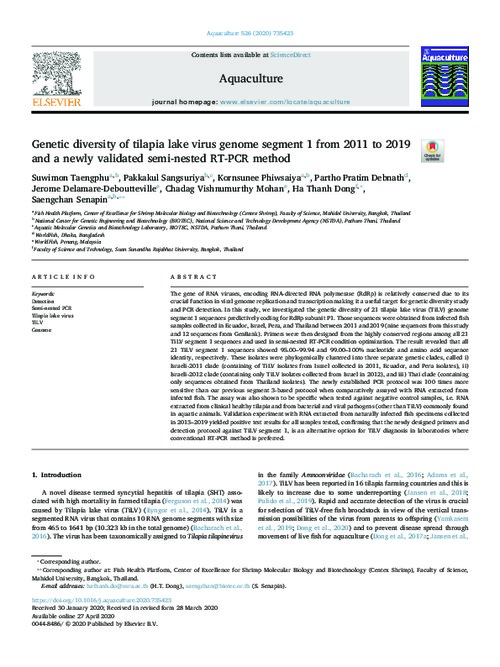Genetic diversity of tilapia lake virus genome segment 1 from 2011 to 2019 and a newly validated semi-nested RT-PCR method

The gene of RNA viruses, encoding RNA-directed RNA polymerase (RdRp) is relatively conserved due to its crucial function in viral genome replication and transcription making it a useful target for genetic diversity study and PCR detection. In this study, we investigated the genetic diversity of 21 tilapia lake virus (TiLV) genome segment 1 sequences predictively coding for RdRp subunit P1. Those sequences were obtained from infected fish samples collected in Ecuador, Israel, Peru, and Thailand between 2011 and 2019 (nine sequences from this study and 12 sequences from GenBank). Primers were then designed from the highly conserved regions among all 21 TiLV segment 1 sequences and used in semi-nested RT-PCR condition optimization. The result revealed that all 21 TiLV segment 1 sequences showed 95.00–99.94 and 99.00–100% nucleotide and amino acid sequence identity, respectively. These isolates were phylogenically clustered into three separate genetic clades, called i) Israeli-2011 clade (containing of TiLV isolates from Israel collected in 2011, Ecuador, and Peru isolates), ii) Israeli-2012 clade (containing only TiLV isolates collected from Israel in 2012), and iii) Thai clade (containing only sequences obtained from Thailand isolates). The newly established PCR protocol was 100 times more sensitive than our previous segment 3-based protocol when comparatively assayed with RNA extracted from infected fish. The assay was also shown to be specific when tested against negative control samples, i.e. RNA extracted from clinical healthy tilapia and from bacterial and viral pathogens (other than TiLV) commonly found in aquatic animals. Validation experiment with RNA extracted from naturally infected fish specimens collected in 2013–2019 yielded positive test results for all samples tested, confirming that the newly designed primers and detection protocol against TiLV segment 1, is an alternative option for TiLV diagnosis in laboratories where conventional RT-PCR method is preferred.
Permalink
Date Available
Type
Publisher
ISSN
0044-8486
Copyright
CC-BY-4.0
Research Themes
Language